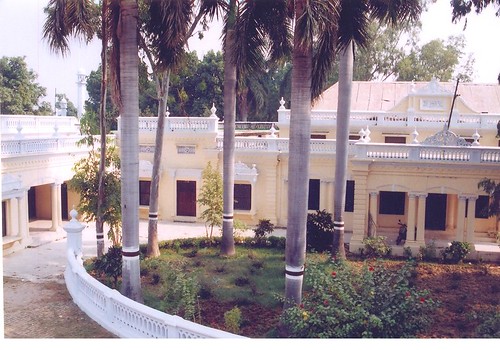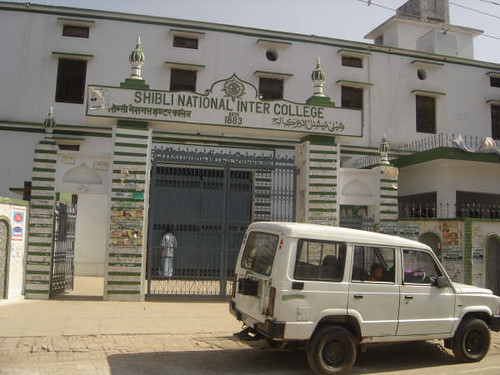By Razi Raziuddin
The district of Azamgarh has been much in the news at present, mostly with terror and violence-related events and episodes. Earlier, Azamgarh had been in the news for its scholars, its poets, its freedom fighters, and its institutions and religious seminaries.
These days it has become fashionable, especially with the media, to relate Muslim fundamentalism related pro-activism (in the North and Western India) with Azamgarh. It seems that all roads of illegalities, be it a hawala/money scam or a bombing episode elsewhere, are connected with the district of Azamgarh.
These too many references to an obscure eastern UP’s mediocre district and its Muslims naturally draws curiosity and urge to know as to why this particular district has attracted the news media and the Law & Order agencies’ interests so much.
I am a native son of Azamgarh, born and brought up to adulthood in my hometown. Since three decades I live in USA, but I remain fully connected with the place, and on informational and emotional level I have never been away from my home town. Therefore, I genuinely believe that I am fully aware of Azamgarh’s each and every significant development of the last fifty plus years.
So let me construct a composite sketch of Azamgarh and its Muslims—in a manner which provides the curious populace some clues and impressions for its Muslims to be so much in the lime-light.

Darul Musannefin Shibli Academy, Photo by Afzal Usmani
On the canvas, geographically and demographically; it is a large district of eastern U.P. with a roughly 30% Muslim population. This Muslim population is segmented into three living zones; majority in its villages, a significant portion in its four-five big Tehseel-town bazaars, and the rest huge population in the city mohallas. Majority of its Muslims claim to be converts from Kshatriyas/ Rajputs around the period spanning from Jahangir to Aurangzeb. Among the rest, are those who associate themselves as Ansaris, Syeds, Qureshis and Idreesis. The overwhelming dominant segment of the Muslim society belongs to this majority Rajput converts. Majority of these are from the farming background, from small land owners to middle level landlords.
Azamgarh Muslims’ modern anthropological story runs in two parts- late 19th to mid 20th century, and post-independence to the present time.
First part
In the first part of the story, post 1857-1957, the area witnessed resurgence in Islamic revivalism, but with a clear mark of reform and community-cum-nationalistic aspirations. Many religious and non-religious intellectuals became visible in this process of renaissance, the tallest among them the personality of Maulana Shibli Nomani. His close association with Aligarh Movement and Sir Syed became instrumental in infusing the spirit of modern education, and later on his stewardship of Nadwatul Uloom became the central character which laid the groundwork for Azamgarh Muslims to embrace the signature campaign of Shibli Nomani; educational aspirations in occidental as well as oriental learning and full participation in the national freedom movement. Following in his footsteps many other joined him at Nadwa, while others embraced Jamia Millia Islamia, Delhi. In a decade’s time Shibli National College was founded, which became the center of modern secular education for Muslims in the eastern district of UP. Along side and around the same period, Darul Musannefin came into existence, becoming the intellectual center of Islamic and literary scholars surrounding Shibli, and his illustrious disciple, Syed Sulaiman Nadwi.
Then in the mid 20s-30s an influential seminary, Al-Islah was established by Shibli’s cousin, Maulana Abdul Hameed Farahi. In fact these three centers became the inspiration and magnet for higher learning for a much broader group of Muslim population from even other regions. These centers became the “Feeder Institutions” from where thousands and thousands of Muslim youths from Azamgarh went to join Aligarh, Jamia Millia, Allahabad and Lucknow universities. Within three decades, from 30s to 50s, two generations of educated Muslims from Azamgarh came out from these various universities, seminaries and colleges as lawyers, teachers, doctors, ulemas, literary scholars in huge numbers.
These newly empowered youths loaded with tools of modern as well as oriental education spread around everywhere including in Azamgarh. The district felt their presence in almost every arena; in courts, in schools, on streets, in hospitals. These personalities and institutions also inculcated in them a character of nationalistic connectiveness. The impact of frequent visits of Maulana Azad , Nehru and other prominent political and religious leaders’ stays at Shibli Academy/ Darul Musannefin have had huge impact on the psyche of the Muslims of Azamgarh. Soon the region became a solid nationalist Muslim corridor, and its Muslim population empowered with the tools of modern and mainstream discourses. This period witnessed the growth of many schools, including few for girls, many seminaries, Shibli College became the largest supplier of school teachers (for Bombay’s Anjuman-e-Islam and Anjuman-e-Khairul Islam run schools), lawyers, and science graduates. Bombay also became a familiar and friendly place for those who were less educated and less fortunate in Azamgarh, to try their luck. A huge number flocked to Bombay, Malegaon, Nasik, and Bhiwandi for job and for establishing small businesses. So this period was a mix of a community’s ascendance to all kind of mobility. Still Azamgarh and its Azmis were more or less confined into islands, pockets and with mediocre level of earnings and with simpler livings.

Shibli College, Photo by Razi Raziuddin
Second part
This first part of the story is quite remarkable, inspirational, and a kind of role-model for many to follow. “Second Part” of Azamgarh’s story is about growth, expansion, economic and political assertion and of fame. The Azamgarh and Azmis in this part-two of the story are divided into three distinct categories- in category one are those whose fathers and families were educated and had jobs either in Azamgarh or elsewhere, and whose children mostly are educated and in professional jobs; in category two are those (educated as well un-educated) who went to Bombay area in huge numbers and then from there landed in the Gulf region, but who still retained close bases/connections with Azmis of the Bombay region; and in category three are those Azmis who are either in Azamgarh’s various Madrassas, in schools/ colleges, or idle sitting at homes getting sustenance from the gulf money.
The combinatorial or cumulative outcome of this last three decades of the second and third generation of Azmis is the enormous amount of wealth and resources that it has accumulated from all directions; from the West, from the Middle-East, and from the Bombay region. It has been popularly said that no other region in the entire North-Eastern India has any Muslim region/populace which is so much empowered with three most critical ingredients of affluence and confidence; modern education, religious education, and wealth. This empowered affluence can be visible observed in Azamgarh’s Muslim dominated areas, in its Muslim-dominated bazaars and villages, which are flooded with madrassas, masajid, schools, shopping bazaars. Whole new planned housing developments have come up with hundreds of up-scaled houses; Muslims are running three private hospitals with total bead strength in the range of 100 or more, dozens of MD doctors and shopping complexes. Very few other Muslim regions can claim to run so many large residential seminaries/ Madrassas, such as the famed Al-Falah, Al-Islah, and Jamiat-ur-Rishaad.

Jama Masjid of Azamgarh, Photo by Razi Raziuddin
There is no doubt that at present there are strong corridors and channels in Bombay, Delhi, Middle-East which have a lot of Azmis, who earn a lot of money, and which finds its way in Azamgarh, and which sustains Azamgarh’s businesses, real estates, its madrassas, its schools and what not. It is also this period which has produced some bad apples, criminals like Abu Salem, aggressive politicians like Abu Aasim, un-regulated money transfer schemes like hawala. So it is this part of the Azamgarh story which catches enormous attention.
In this saga and journey of an entire community towards an upward mobility, two other characteristics remain prominently consistent; the secular culture of Azamgarh, Azmi Muslims and their relationship with the Azmi Hindus, and least level of migration to, and affiliation with Pakistan. Azmi Muslims are perhaps one of the most nationalistic, socialist-oriented, secular Muslims in the country. It is, therefore, disturbing to find that certain quarters in the country, media, socio-political organization labeling the district as “soft” on nationalism, or have sympathies with fundamentalism.
—-
Razi Raziuddin is a Medical Scientist by profession. A native of Azamgarh, educated at Shibli National College, Aligarh Muslim University (B.S. & M.S.), Banaras Hindu University (Ph.D.), he has been living in the USA since 1980.

